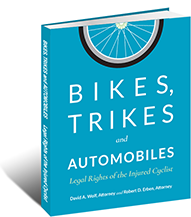Bikes, Trikes, and Automobiles
 Bicycles have been around since the early 1800s and they have gained in popularity ever since. Unlike the early 1800s when bikes were used purely for transportation, today’s bikes are ridden for exercise, for commuting, for racing in all shapes and forms, and for fun; they are ridden all over the world, by people of all ages, and from all walks of life. As bicycling continues to gain in popularity, so do the risks and dangers inherent in any activity that involves vehicles, other cyclists, trails, roadways, sidewalks, obstacles, and pedestrians. It is these risks and dangers that cyclists face every day when they pedal away to their destinations.
Bicycles have been around since the early 1800s and they have gained in popularity ever since. Unlike the early 1800s when bikes were used purely for transportation, today’s bikes are ridden for exercise, for commuting, for racing in all shapes and forms, and for fun; they are ridden all over the world, by people of all ages, and from all walks of life. As bicycling continues to gain in popularity, so do the risks and dangers inherent in any activity that involves vehicles, other cyclists, trails, roadways, sidewalks, obstacles, and pedestrians. It is these risks and dangers that cyclists face every day when they pedal away to their destinations.
This book titled - Bikes, Trikes and Automobiles: Legal Rights of the Injured Cyclist - was specifically written for injured cyclists seeking answers and information when they suffer personal injuries as a result of an accident. The issues and challenges presented in the aftermath of an accident involving personal injuries to a cyclist are many in number. They range from medical treatment to insurance issues to financial issues to legal issues and beyond. It is extremely difficult for an injured cyclist, who may know very little of the specific bicycle laws in his or her state, to handle all of the issues that inevitably arise. Further, most people have limited experience and knowledge in dealing with legal and insurance matters. This book provides information to injured the cyclist and his or her family to provide information and guidance in the aftermath of an accident causing personal injuries to the cyclist. It is important for cyclists to be educated as to these issues and legal matters so that they can make an informed decision about medical treatment, insurance coverage, insurance claims, reimbursement, and legal representation. Although this book contains invaluable information, it is not intended for use as a recipe or formula for handling a claim or case on behalf of an injured or killed bicyclist.
There are specific laws that govern the operation of motor vehicles on the streets, roadways, and highways. Furthermore, there are laws and regulations applicable to the operation of a motor vehicle in or near bicyclists. For instance, many states have adopted a 3 feet or more rule when passing a bicyclist and / or when driving near or approaching a bicyclist. Unfortunately and tragically, a bicyclist suffers personal injuries as a result of a driver who is not obeying the traffic rules and regulations OR is simply driving carelessly and recklessly. Careless and distracted driving cause far too many accidents and personal injuries to cyclists who have every ride to use and share the road with motorists.
There are far too many factual and legal complexities and factors in any given personal injury claim or case to be able to write a “cookie cutter” manual on how to handle bicycling injuries. Therefore, this book should only be used as a guide and reference in pursuing a legal claim or case with the benefit of the services and representation of an experienced Bicycle Injury Lawyer. When a cyclist is injured as a result of the negligence of others, the cyclist deserves a voice and an advocate to protect and enforce his or her rights under the law. This book is intended to provide the injured cyclist with information to help him or her better deal with the issues of a personal injury case. The back of has a great message about Bicycles and Bicyclists: Powered by People with Enforceable Legal Rights.
 David Alan Wolf, Personal Injury Attorney Home
David Alan Wolf, Personal Injury Attorney Home



